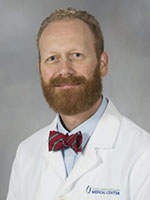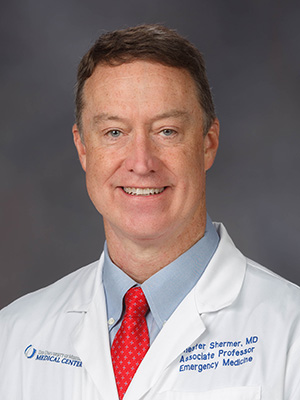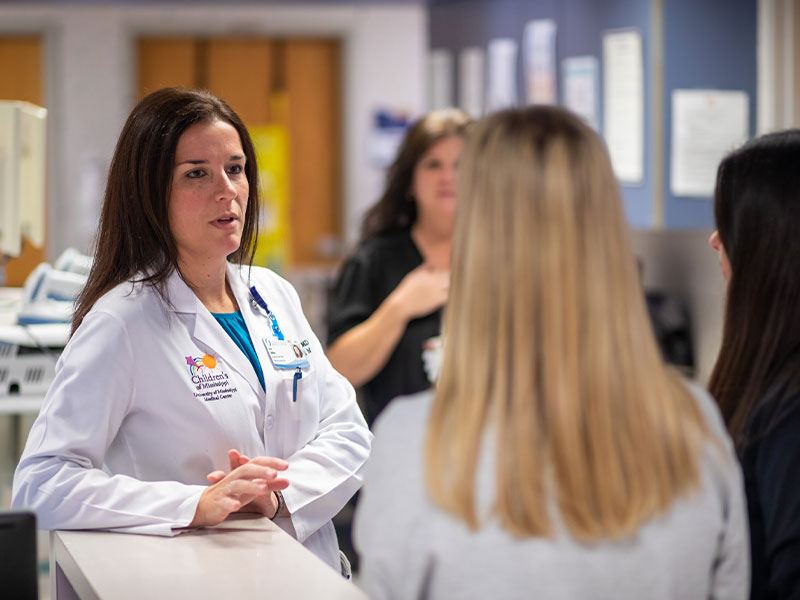If work events leave caregivers traumatized, help is on the way

Dr. Michelle Sheth will not forget the month, date and year that she became a second victim.
She had recently completed her fellowship and was administering anesthesia to an infant during a surgery. The baby did well, but a surgery resident made a critical mistake and used an incorrect piece of equipment toward the end of the procedure, after the surgeon had exited the OR.
“I didn’t notice,” Sheth said. “I didn’t stop the resident.”
Minutes later, the baby died.
“I replayed that event in the OR over and over for days,” Sheth said. “I tried to rationalize things.”
Sheth was able to continue caring for patients, but thought about the surgery and the baby during quiet moments. For several weeks, she had flashbacks when she worked in the same OR.
She retrieved the piece of equipment and kept it in her desk.
“Every time I sorted through there and saw it, I thought about it,” said Sheth, today a University of Mississippi Medical Center associate professor of anesthesiology. “It took me a very long time to forgive myself. It wasn’t my fault that I let him put in (the device). I could not release myself from the responsibility of that preventable death.”
Sheth needed psychological first aid. She didn’t have a workplace support system to ensure she got it.
Health care providers face stress from patient care every day, and most handle it well. But when that stress becomes potentially traumatic, the caregiver can quickly become the emotional or psychological “second victim.” Too often, they experience shame and guilt, self-doubt, burnout and other problems that cause personal anguish and hinder their ability to deliver safe, compassionate care.

A typical second victim is part of a team that takes care of a patient, “and unfortunately things didn’t go the way the team wanted it to go,” said Dr. Daniel Williams, associate professor and director of the Division of Psychology in the Department of Psychiatry and Human Behavior. “When you put your heart and soul into doing everything you can to help a patient, sometimes that can be devastating.”
Second victims can be created when a patient dies. It can happen when a treatment plan fails.
It can happen if a caregiver makes a medical error that results in a patient’s death or harm, including “never” events such as giving a patient an incorrect medication or dosage, operating on the wrong body part, or infusing patients with the wrong type blood.
An employee might be verbally or physically assaulted by a patient, family member or visitor. “These things can be incredibly traumatic, and it can remove your sense of safety and security,” Williams said. “It can feel very threatening just to come back to work.”
And, hospitals can create second victims by not having a process to help them cope when something goes wrong.
“We want to have a system in place to support health care providers on the front lines,” Williams said. “We are the only Level I trauma center in the state. We see the most complex patients, needing the highest levels of care, and most likely to have the worst outcomes. We will see family members who will treat us poorly along the way.
“We need a way to intervene and support the caregivers, to have a peer response team who understands what it’s like to be in your position, and to be there 24/7 for confidential support.”
The Medical Center has created that team, called RISE, or Resilience in Stressful Events, at the urging of Sheth and other caregivers who have seen and experienced the need. Members of the group, most of them front-line caregivers, are available around the clock. They can call a hotline, 601-815-7473, and connect with a team member for immediate support. The live date for the line will be announced soon.
To get the ball rolling, Sheth came together with Dr. Joshua Mann, professor and chair of the Department of Preventive Medicine and director of the Office of Well-Being; Dr. Lisa Didion, a pediatric hospitalist and associate professor of pediatrics; and Elizabeth Toony, director of clinical risk management. About 40 senior leaders, plus 28 employees designated as peer responders, underwent training led by experts from the Johns Hopkins Hospitals RISE team.
Johns Hopkins partners with the Maryland Patient Safety Center to provide training nationwide using the Caring for the Caregiver program, which guides hospitals in setting up peer responder programs that deliver psychological, emotional and non-judgmental support following difficult events.
Johns Hopkins experts detailed cases of second victims making national headlines. Among them: Kim Hiatt, a 25-year veteran critical care nurse at Seattle Children’s Hospital.
In 2010, she accidentally gave 10 times the intended dose of a medication to a critically ill infant and reported the error. The baby died five days later. Hiatt was fired, rejected by her profession and couldn’t find work.
Seven months after the baby’s death, Hiatt killed herself.
Sheth was working in Oklahoma City several years ago when one of her colleagues performed a spinal fusion surgery. “The patient woke up paralyzed,” Sheth said. “I witnessed how devastating this can be.”
Her coworker needed encouragement to eat and rest. She questioned her skills and worried she’d be fired. “I was the support structure she needed to get back on her feet,” Sheth said.
It took two weeks for her coworker to return to the OR. “This was a reaffirmation that this support structure is needed, and that it works,” Sheth said.
It was after both she and her husband, assistant professor of anesthesiology Dr. Anesh Rugnath, became second victims that Sheth resolved to start a program at UMMC. She presented a Grand Rounds talk on second victims in 2017.
At the beginning, she asked second victims in the room to raise their hands and no one did. At the end, she asked again. “At least five or six people raised their hands,” she said. “I realized other departments needed second victim awareness and a culture of taking care of each other.”
The Office of Well-being took up the charge, building the peer response team from the ground up. “The team member is designated to be there just to support you, and to be present in your time of need,” said Williams, a team member who also is associate director of the Office of Well-being. “It can be a lonely and isolating experience to go through this.”
Unless a patient is harmed, an event that must be reported, conversations should always be private, Williams said. RISE peer responders also can privately offer additional resources, including talking to a mental health provider or someone with the employee assistance program.
Not everyone is suited for the team. “We want someone who can really focus on being empathetic. If someone is focusing on their own previous experience being a second victim, they might have a hard time separating that from the experience of the employee,” Williams said.
Just as importantly, RISE peer responders don’t assign blame, and don’t weigh in on whether an employee did or didn’t do a good job in handling a bad situation.
“We want someone who is not a problem solver,” he said. “They are a very good listener, and they should be able to focus on putting themselves in the other people’s shoes and to help them process their experience.”

“As a physician where we are always trying to fix things. I’ll have to guard against that, and just listen,” said Dr. Chet Shermer, professor of emergency medicine and a response team member. “Your natural instinct is to console and fix, instead of letting them unburden themselves. It’s nice to be part of the healing process.”
Didion was working at another hospital when she became a second victim.
“I had a patient who was medically complex on the floor. She was a home ventilation patient,” she remembered. “I saw her and she was fine, and 30 minutes later, there was a code called in her room.

“She died. I felt awful, and I felt awful for the family. I immediately wondered if we had missed something,” Didion said.
She sought out the patient’s regular doctor. “She gave me no support. Here I was, in tears, going to find someone to talk me through this, and there was nobody.”
In UMMC’s Adult Emergency Department, Gordon Gartrell and his staff “deal with a lot of deaths, and a lot of violent acts. That’s part of the job most of the time,” he said.
“People come in with bad stories,” said Gartrell, a nursing supervisor. “You might not anticipate them having such a poor outcome, but things can go south. Sometimes when they get to us, there’s nothing we can do.
“For an ED nurse, that’s really hard. We are taught to act,” Gartrell said. “We make clinical decisions with physicians on how to take care of acutely injured patients. When there’s nothing you can do, it makes you feel helpless.”
Gartrell remembers when he was a “very green” nurse and helped a coworker who, without warning, became a second victim. “We had an 18-year-old patient who dove into a creek and suffered a severe spinal cord injury,” he said. “One of my peers had a child who had a similar outcome, and she was very, very emotional.
“We pulled together to make sure we did everything as appropriately as possible for the patient, but we also took care of our own.”
Even the most experienced providers can benefit from the new program, Williams said. “Ignoring our experiences and emotions is not the way to take care of our well being,” he said. “This is for everyone.”
Williams is a second victim. “I’ve certainly had patient suicides,” he said.
“I didn’t have a second victims program, but I had colleagues I could turn to, and I can’t imagine going through an experience like that without colleagues to give me the emotional support that I needed at the time.”
As a RISE peer response team member, Didion will strive to give second victims what she didn’t get. “First and foremost is actively listening, and listening with empathy. As the RISE responder, our job is not to fix the problem. It’s to listen and hear the story through their eyes, and help provide resources that are needed from that standpoint.”
By taking steps to create the peer response team, Didion said, the Medical Center is elevating its importance.
“Our leadership sees this as an opportunity to improve the bedside work, and the work we do through the organization,” she said. “We are only as good as the care we provide, and for us to provide the best care for every patient, we have to take care of ourselves.
“A lot of that care happens at work.”


